Cottage ventilation: options for organizing an air exchange system + device rules
In a private house, landscaping and comfort are important. A comfortable microclimate will provide heating and ventilation of the cottage, civilized conditions will create water and electricity, sewage and gas. Ideally, all systems are designed at the same time, taking into account their further interaction.
We will talk about how to organize a stable high-grade air exchange. We’ll show you which scheme is better to prefer and how to choose equipment that will work perfectly for the benefit of the owners. You will learn all about the intricacies of designing an autonomous ventilation system.
The content of the article:
Ventilation options
Impeccably functioning ventilation of the building is not only cool, but also clean air that meets all sanitary standards. It will be a serious mistake to believe that a conventional range hood or air conditioner will solve this problem, as the fresh air added by the climate system simply combines with the exhaust air, diluting it, and bacteria and odors remain.
Due to the widespread universal sealing, the rules of air infiltration, widely used in construction during the Soviet era, no longer work. Then, for ventilation of apartment buildings built from environmentally friendly building materials, there were enough slots in wooden frames and exhaust ventilation ducts.
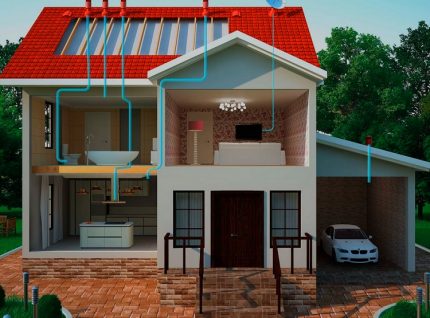
Now, for the sake of sealing, effective seals are installed in window and door frames to prevent natural influx. In building structures, impermeable films and heaters are used that prevent not only leakage of thermal energy and moisture penetration, but also air flow.
All this saves energy, but leads to the difficulty of natural air exchange between the street and the interior of the houses.In order to ensure a regular supply of fresh air to confined spaces and arrange ventilation. It is natural, mechanical and mixed.
The principle and operation of the gravitational system
The natural system that provides regular air exchange in the cottages operates due to gravitational forces. The movement of air flows in it is justified by the difference in pressure, temperature and air density outside the windows and inside the building.
Cool street air is drawn in through the supply valves, open air vents, and plastic transoms ajar for micro-ventilation. A new fresh portion pushes the exhaust air mass to the hood, which in private buildings can be in the ventilation shaft, in the ceiling with access to the attic, and then to the street, or through the wall directly to the street.
The draft force in the chimney is more influenced by wind and cross-section, length and other parameters of ventilation ducts. However, this only works when the street temperature is not more than 12-15 degrees Celsius, while increasing values - the efficiency of the hood is significantly reduced.
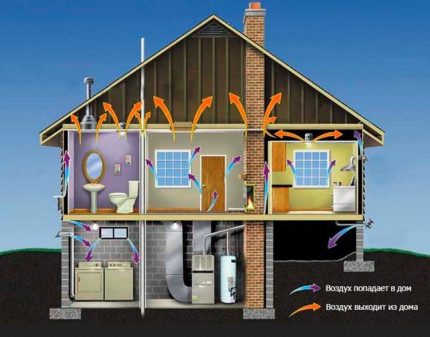
In winter, on the contrary, air flows upward intensify, and heat “flies out into the pipe”. There are methods to improve performance. natural ventilation system - installation of a deflector or check valves on the channel, but this does not fundamentally change the situation.
According to sanitary standards, the amount of incoming clean air is:
- 3 cubic meters / hour per 1 square. meter of rooms;
- 25 cubic meters / hour for bathrooms;
- 35 cubic meters per adult.
Often they use for convenience a different standard - the rate of air exchange, which reflects how many times the air should be replaced in the room within an hour (in Russia this figure is at least 0.35 times / hour).
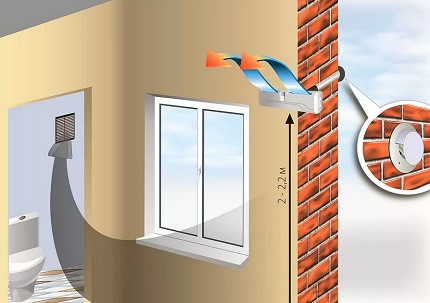
In practice, the discrepancy between the quality and composition of the air mass with sanitary and epidemiological standards is manifested in the following negative factors:
- in violation of the temperature regime;
- in the appearance of dampness, mold;
- in the manifestation of tobacco smoke and kitchen odors;
- in increasing the level of carbon dioxide.
The main advantage of the gravitational type of ventilation is only simplicity and minimal costs. After all, the natural scheme does not fully fulfill the functions of air renewal assigned to it in the hot period when, for the same gravitational reasons, air can move in the opposite direction: from the house through the window.
Mechanical ventilation and its types
In order to prevent such phenomena and balance the flows of fresh and polluted air, equipment is installed in cottages for mechanical (or, as it is called forced) regulation of air exchange. The mechanical ventilation systems include: not only the supply and exhaust devices, but also the supply and exhaust system.
Installation of systems involves the installation of nodes and blocks for the inflow and exhaust of air into the duct system (their simplest representatives are kitchen hoods and ducted air conditioners).
A supply and exhaust unit is a grouping of supply and removal in one monoblock. This class also includes circuits with fans mounted simultaneously in the hood and in the inlet. Note that in supply and exhaust circuits only a hood or only an inflow always works, and the owner has a choice which is preferable to use.
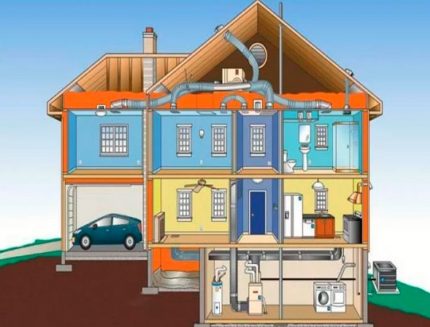
In addition to the main rooms, in which it is necessary to provide a healthy comfortable environment with the help of ventilation, in most country houses there are a large number of technical, utility and special rooms.
Depending on the purpose, they require an individual approach to the organization of their service:
- In the bathhouse, sauna and pool, ventilation is needed with humidity control.
- In a fireplace and a boiler room with an atmospheric gas boiler, it is necessary to maintain combustion by supplying oxygen.
- In dressing rooms and pantries, a simple ventilation is enough.
If clean air enters the living rooms, children’s and bedrooms, and is removed from latrines, bathrooms and kitchens, this is a typical example of properly arranged ventilation of the cottage and well-designed organization of any type of system, regardless of the motivation factor, gravitational or mechanical.
Exhaust ducts are required to remove airflow. ventilation pipes. They are round and rectangular in cross-sectional shape, and rigid and flexible in terms of stiffness. Flexible aluminum and polymer corrugated ducts.
Flexible ones, due to corrugation, have the greatest resistance, however there are situations when you cannot do without them. Corners are easier and faster to perform corrugation. It is also placed in areas that compensate for the linear thermal expansion of plastic ventilation pipes and ducts.
Ventilation channels in cottages are laid hidden and open. In the first case, they are laid during the construction of walls, in the second - laid on top of structures. Most often, open air ducts mask under suspended ceilings.

When installing a standard supply ventilation system, two difficulties appear over time:
- a large amount of thermal energy spent on heating the incoming air, and going into the exhaust pipe;
- insufficient indoor humidity during the cold season.
Installing a recuperator quickly and efficiently resolves these difficulties.
Supply and exhaust system with recuperator
Now they are increasingly used forced-air and exhaust installations with the function of recuperation, the heat exchange process between the waste heat stream leaving the room and the incoming cold air.
Depending on the heat carrier heating the air, recuperators are water and glycol. Depending on the type of heat exchanger recuperating devices are divided into lamellar and rotor. A feature of the rotary is a rotating drum-heat exchanger and the absence of freezing.
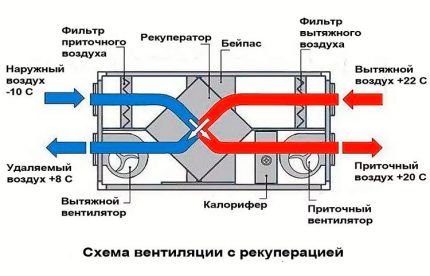
Recuperators are produced for installation on the roofs of serving houses. There are models located in the attic space, there are also apartment options that process individual housing in high-rise buildings.
The characteristics of the plate model depend on the material of the heat exchanger cartridge (plastic, aluminum, cellulose and stainless steel). Both types of recuperators are considered the most popular due to their simplicity, reliability and high efficiency; they are effectively used in ventilation systems of cottages.
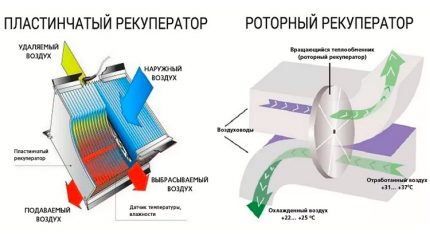
Application supply and exhaust devices with a recovery function supports comfortable conditions and provides:
- relative humidity, by draining or moistening;
- balance between the volume of supply and exhaust air;
- comfortable air temperature by cooling it with air conditioners or heating with heating devices.
Ventilation units with a recuperator are an energy-saving system that allows you to save thermal energy up to 50% in winter, while usually with the onset of cold weather a large amount of it is spent on heating the fresh supply air.
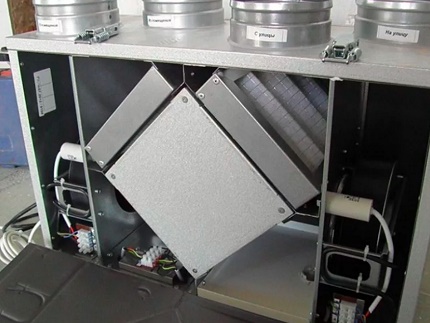
Systems partially warm the incoming stream, and the built-in air heater brings the temperature to the desired value.
Technical aspects when developing ventilation
When choosing equipment for a ventilation system, it is necessary to use several basic design indicators in the work. For example, multiplying the values of the volume of the room and the frequency of air exchange, you can get the value of the production capacity of the fan necessary for the full service of the cottage.
Those who are considering how to properly make ventilation in the cottage, of course, should take into account possible losses and choose a fan with a margin. One important point should be taken into account - the equipment of the exhaust system should be 10-15% more powerful than the supply system, so that the used air does not accumulate in the room.
For the proper organization of ventilation in the cottage, several important factors must be taken into account:
- The location of the exhaust ducts. Pipes should be placed mainly vertically and in a straight line, preferably without turns (since each turn reduces traction by 10%) and the same diameter over the entire length of the route.
- The height of the exhaust pipe. The mouth of the exhaust pipe should rise above the roof of the cottage at least half a meter (air should be removed above the roof). The installation of a deflector also significantly enhances the circulation of air flow (up to 20%).
- Cross section and dimensions of ventilation ducts. The round section is considered to be the most economical and in practice, rigid round ventilation ducts are more often used, due to the ease of installation, the least resistance and, as a result, the high intensity of the air flow.
Introduces the rules for calculating the area of ducts next article, which is worth reading to all owners of suburban property.
Also, to maximize traction, use the maximum diameter and length of the pipe to be laid if possible.
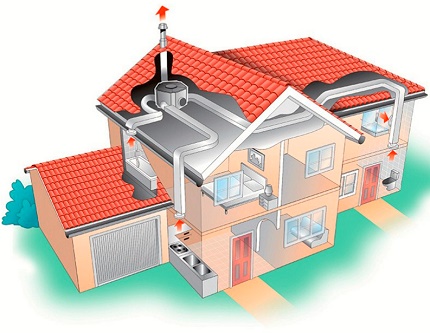
When developing a supply and exhaust system, it is necessary to remember some technical points:
- the amount of incoming and outgoing air must be balanced;
- clean air is delivered to all rooms, and dirty outflow is made from areas with unstable humidity and temperature conditions;
- ventilation from the bathroom and extractor hood cannot be combined into one channel;
- the speed of the circulating flows in the exhaust pipes and ducts should not be more than 6, and at the outlet 3 meters per second.
The mechanical ventilation system is certainly more productive than the natural “sister.”Its work is completely unaffected by weather data, its activation and deactivation can be automated. However, it is much more complicated and more expensive in the device.
Conclusions and useful video on the topic
The following video will familiarize you with the installation steps of the ducts:
The principle of operation of the gravitational ventilation system is presented in the video:
Ventilation hood manual:
So, in the cottage, regardless of what building material and in what area it is built, full air exchange is necessary. A reasonable choice would be the supply and exhaust ventilation, the development of which should definitely be included in the project.
Knowing the principles of organization, the device of the gravitational system can be easily dealt with without the involvement of builders. The design and installation of mechanical ventilation is more correctly entrusted to heat engineers.
Want to share your own experience in building a ventilation system? Do you have information on the topic of the article, which may be useful to site visitors? Please write comments, ask questions and post photos in the block form below.

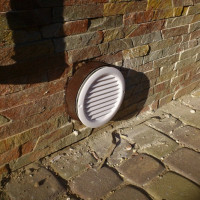 Ventilation of the foundation of the house: rules and options for organizing air exchange
Ventilation of the foundation of the house: rules and options for organizing air exchange 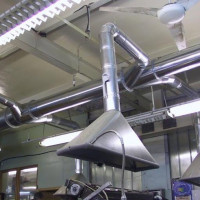 Ventilation of industrial premises: rules for the organization of air exchange
Ventilation of industrial premises: rules for the organization of air exchange 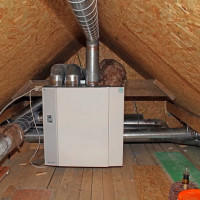 Ventilation in a two-story private house: options for organizing trouble-free air exchange
Ventilation in a two-story private house: options for organizing trouble-free air exchange 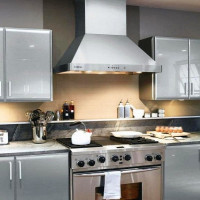 Ventilation in houses with gas stoves: rules and regulations in the organization of stable air exchange
Ventilation in houses with gas stoves: rules and regulations in the organization of stable air exchange  Frequency rate of air exchange in office premises: norms and rules for the organization of proper air exchange
Frequency rate of air exchange in office premises: norms and rules for the organization of proper air exchange 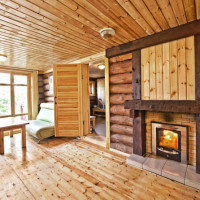 Ventilation in the dressing room: options and methods for arranging the air exchange system
Ventilation in the dressing room: options and methods for arranging the air exchange system  How much does it cost to connect gas to a private house: the price of organizing gas supply
How much does it cost to connect gas to a private house: the price of organizing gas supply  The best washing machines with dryer: model rating and customer tips
The best washing machines with dryer: model rating and customer tips  What is the color temperature of light and the nuances of choosing the temperature of the lamps to suit your needs
What is the color temperature of light and the nuances of choosing the temperature of the lamps to suit your needs  Replacement of a geyser in an apartment: replacement paperwork + basic norms and requirements
Replacement of a geyser in an apartment: replacement paperwork + basic norms and requirements